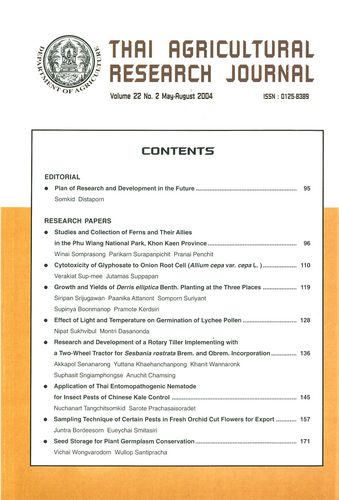Sampling Technique of Certain Pests in Fresh Orchid Cut Flowers for Export
DOI:
https://doi.org/10.14456/thaidoa-agres.2004.13Keywords:
fresh orchid cut flower;, export, sampling, pestAbstract
The data pests found in fresh orchid cut flowers (Dendrobium hybrid), contained in large boxes for export was collected by stratified multi- stage sampling at the Air Cargo Terminal Bangkok International Airport during January- September 2002. The export Level was classified from the number of large boxes per shipment into 8 stratum. Sampling of each stage was done by simple random as following: the sample numbers of shipment in each strata was proportional allocated to 221 shipments as total. The number of random of large boxes in each random shipment was 11 percent of upper bound of strata then sampled only one small box from 5 small boxes in each random large box. Alter one small box, contained 6- 9 bunches was randomly selected from large box, only one bunch contained 8- 10 stems was also randomly selected. Every flower in 8- 10 stems was inspected for existing pests especially thrips. Only numbers of alive thrips found on the bunch were statistical analyzed because very few alive snails and all dead red spider mites and beet armyworms were found. The probability of the acceptance on the basis that no thrips found was calculated by binomial distribution. Consideration of sampling plan with 8 lines of operating characteristic curves, represented 8 stratum which were varied by the different number of random large boxes sampling and testing of homogeneity of regression coefficients, The results revealed that the random sampling of all levels in a lot of large boxes per shipment for export should be at least 4 large boxes or about 40 stems per shipment for thrips inspection by hierarchy stage above. lf the random sampling was reduced to 3 or 2 large boxes, the Lot Tolerance Percent Detective (LTPD) would increase at the specification of 10% consumer risk level or .β =.10 (probability of the shipment acceptance though that shipment still has thrips accidentally.) such as n=4; LTPD =44%, n=3; LTPD=54% and n=2; LTPD=68%. Consequently, the probability of pest intercepted by the destination countries is higher. So it is depended on the judgement of the officer in charge, if the officer wants to reduce the time use and the damaged products for inspection by reducing the number of random large boxes, but the reduction will affect the risk of interception of thrips at the destination.
Downloads
Published
How to Cite
Issue
Section
License

This work is licensed under a Creative Commons Attribution-NonCommercial-NoDerivatives 4.0 International License.
Thai Agricultural Research Journal



